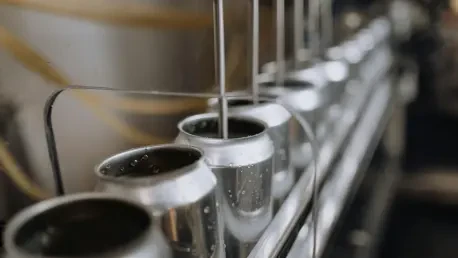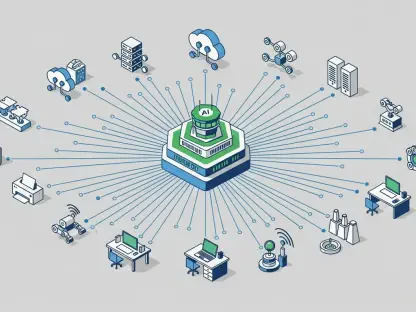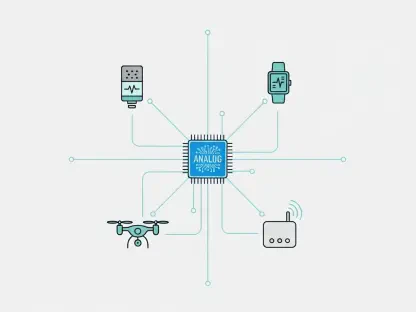The food production industry, long characterized by hands-on labor and conventional equipment, is experiencing a seismic shift as smart automation takes center stage. Driven by the power of artificial intelligence (AI), these cutting-edge technologies have moved beyond being a mere advantage to becoming an essential component for manufacturers striving to meet escalating consumer demand, combat persistent labor shortages, and optimize complex operations. This transformation touches every facet of the sector, from ensuring consistent quality control to maintaining equipment uptime with minimal disruption. Smart automation introduces a level of efficiency and adaptability previously unattainable, enabling companies to scale production while addressing modern challenges. As the industry evolves, the adoption of intelligent systems signals a fundamental reimagining of how food is processed and packaged, paving the way for a future where technology and human effort work in seamless harmony to drive progress.
Harnessing AI for Unmatched Efficiency
Smart automation distinguishes itself from traditional approaches by embedding AI to combine reliability with remarkable flexibility in food production. Technologies such as machine vision and digital twins enable pinpoint accuracy in quality control and process refinement, even when faced with inconsistent or variable conditions. A striking example comes from Yango Robotics, where an AI-powered palletizing system reduced costs by an impressive 42% per pick and doubled throughput by adeptly managing diverse stock units, regardless of stacking configurations. This demonstrates how intelligent automation can tackle intricate tasks with precision, directly translating to significant operational savings. Beyond cost reduction, such systems enhance the ability to adapt to fluctuating production needs, ensuring manufacturers remain agile in a competitive landscape. The integration of AI not only streamlines workflows but also sets a new standard for what efficiency means in modern food manufacturing, pushing boundaries that once seemed out of reach.
Further illustrating AI’s impact, companies like Sollas have leveraged Siemens’ technology to achieve extraordinary gains through digital twins, which simulate and optimize packaging processes before physical implementation. This approach resulted in a 33% output increase, jumping from 120 to 160 boxes per minute, showcasing how virtual testing can preemptively solve real-world bottlenecks. Unlike traditional trial-and-error methods, digital twins minimize risks and resource waste by perfecting systems in a simulated environment. This capability is particularly vital in an industry where speed and precision are paramount to meeting market demands. The measurable improvements seen in such case studies underline a broader trend: AI-driven tools are not just enhancing existing processes but fundamentally reshaping how food production lines operate. By embracing these innovations, manufacturers gain a critical edge, ensuring they can scale efficiently while maintaining high standards of quality across diverse product ranges.
Addressing Labor Gaps with Digital Empowerment
One of the most pressing challenges in food production today is the ongoing labor shortage, intensified by an aging workforce and the loss of specialized knowledge as experienced workers retire. Smart automation offers a compelling solution through connected worker platforms like Augmentir, which deliver real-time guidance and tailored training to less-experienced staff, enabling them to handle sophisticated tasks with confidence. A global packaging company adopting this technology reported a dramatic 72% reduction in onboarding time alongside an 18% surge in workforce productivity. This shows that automation extends far beyond mechanization—it actively supports human workers by closing critical skill gaps. By providing accessible, data-driven assistance, these platforms ensure that even newer employees can contribute effectively, reducing dependency on seasoned veterans and maintaining operational continuity in a tight labor market.
Beyond simply filling immediate staffing voids, connected solutions foster a more resilient and adaptable workforce capable of evolving with technological advancements. These platforms integrate seamlessly into daily operations, offering step-by-step instructions and performance feedback that enhance learning curves without overwhelming users. Unlike older training methods that often required extensive time and resources, digital tools provide instant access to expertise, empowering employees to troubleshoot issues on the fly. This shift not only boosts individual performance but also strengthens overall team dynamics, as workers gain confidence in their roles. Importantly, such systems help mitigate the risk of errors that can arise from inexperience, safeguarding product quality while keeping production schedules on track. As labor challenges persist, smart automation proves to be a vital ally, ensuring that human capital remains a cornerstone of success rather than a limiting factor in food manufacturing.
Minimizing Disruptions Through Predictive Insights
Unplanned downtime poses a significant threat to food production, often leading to costly delays and lost output, but AI-powered predictive maintenance is revolutionizing how manufacturers manage equipment health. By analyzing machine data to detect anomalies before they escalate into failures, these systems enable proactive interventions that keep operations running smoothly. A notable instance involves a packaging firm utilizing Senseye’s platform, which saved over 100 hours of downtime annually per site by leveraging existing data for actionable insights. This approach eliminates the need for expensive hardware overhauls, offering a cost-effective and scalable solution to a pervasive problem. Predictive maintenance not only preserves production timelines but also extends the lifespan of critical machinery, allowing companies to maximize their investments while minimizing unexpected interruptions.
Diving deeper, predictive maintenance represents a shift from reactive to strategic equipment management, fundamentally altering how food manufacturers approach operational reliability. Unlike traditional schedules that rely on fixed intervals or post-failure repairs, AI-driven tools continuously monitor performance metrics to forecast potential issues with remarkable accuracy. This foresight enables maintenance teams to schedule repairs during planned downtimes, avoiding the chaos of emergency stoppages. Furthermore, the data collected through these systems can inform long-term improvements, identifying patterns that reveal underlying inefficiencies or design flaws. For an industry where every minute of production counts, such precision is invaluable, ensuring that resources are allocated effectively and customer commitments are met without delay. As more companies adopt these technologies, predictive maintenance is becoming a benchmark for operational excellence, redefining standards of uptime and efficiency.
Navigating Barriers to Automation Adoption
While the advantages of smart automation are undeniable, integrating these technologies into food production is often met with significant obstacles, particularly for firms grappling with outdated infrastructure or limited budgets. Legacy systems, confined factory spaces, and financial constraints frequently hinder comprehensive overhauls, making the transition seem daunting. However, modular solutions like mobile robotics and open-architecture platforms provide a feasible entry point by supporting incremental upgrades that align with existing setups. Despite this, hurdles such as cybersecurity vulnerabilities, data integrity concerns, and skepticism from workers accustomed to manual processes continue to pose challenges. Addressing these issues requires starting with targeted, high-impact projects that demonstrate clear value, thereby building trust and momentum for wider implementation across the organization.
Expanding on this, overcoming adoption barriers demands a strategic blend of technological innovation and cultural adaptation within food production environments. Cybersecurity risks, for instance, necessitate robust safeguards to protect sensitive operational data from breaches that could disrupt entire supply chains. Simultaneously, ensuring data accuracy is critical to prevent AI errors that might undermine system reliability. Equally important is tackling workforce resistance, often rooted in unfamiliarity with automated tools or fear of job displacement. Transparent communication about automation’s role as a supportive tool, coupled with comprehensive training programs, can ease these concerns, fostering acceptance. By piloting small-scale initiatives—such as automating a single production line—companies can showcase tangible benefits like reduced errors or faster output, paving the way for broader acceptance. This measured approach ensures that the shift to smart automation aligns with both operational realities and human dynamics.
Redefining Partnerships with Equipment Innovators
Original equipment manufacturers (OEMs) are playing a pivotal role in the automation wave, not merely by enhancing machinery but by reimagining their business frameworks to align with industry needs. Concepts like “Machinery as a Service” (MaaS) and the integration of proprietary AI software, as exemplified by Siemens, point to a future where OEMs transition from traditional product sales to offering sustained, data-driven services. This model emphasizes long-term partnerships, where equipment providers guarantee uptime and efficiency through predictive analytics and tailored support. Such a shift redefines customer relationships, positioning OEMs as integral collaborators in operational success rather than mere suppliers, and it signals a broader trend toward platform-based innovation in food production.
Delving further, this evolution among OEMs reflects a strategic response to the growing complexity of food manufacturing demands, where flexibility and reliability are paramount. By embedding AI into their offerings, equipment providers enable manufacturers to adapt swiftly to market shifts, whether through real-time performance monitoring or customized maintenance plans. The MaaS model, in particular, shifts financial burdens by allowing companies to pay for usage rather than upfront capital costs, making advanced technology more accessible to smaller players. Additionally, this service-oriented approach fosters continuous improvement, as OEMs gather operational data to refine their solutions over time. For food producers, partnering with forward-thinking OEMs means gaining not just tools but a competitive edge through ongoing innovation. As this trend gains traction, it promises to reshape industry dynamics, prioritizing collaboration and adaptability in an increasingly automated landscape.
Harmonizing Technology with Human Potential
Smart automation in food production is not aimed at sidelining workers but at amplifying their capabilities while optimizing mechanical processes for peak performance. Platforms like Augmentir play a crucial role by upskilling employees through intuitive, data-driven guidance, significantly reducing training durations and easing the adoption of complex systems. This focus on workforce development helps alleviate cultural resistance often encountered when introducing new technologies, reassuring staff that automation serves as a partner rather than a replacement. By striking a balance between technological advancement and human expertise, the industry ensures that both elements contribute to a cohesive, efficient operation, fostering an environment where innovation enhances rather than disrupts established roles.
Moreover, this synergy between technology and human capital builds a foundation for sustainable growth in food production, addressing both immediate needs and long-term aspirations. Digital tools empower workers to take on more strategic tasks, such as interpreting data insights or refining automated processes, rather than being confined to repetitive manual labor. This elevation of roles not only boosts morale but also cultivates a culture of continuous learning, where employees grow alongside technological advancements. At the same time, automation handles high-volume, precision-driven activities, freeing up human resources for creative problem-solving and decision-making. The result is a workforce that feels valued and equipped to navigate an evolving landscape, while manufacturers benefit from heightened productivity. This dual emphasis on people and technology stands as a blueprint for successful automation integration, ensuring lasting impact across the sector.
Paving the Way for Future Innovations
Reflecting on the strides made, smart automation has proven to be a game-changer in food production, delivering unprecedented efficiency and adaptability through AI-driven tools that tackle long-standing inefficiencies. Predictive maintenance curtails costly downtimes, while connected platforms bridge labor gaps with empowering training solutions. Though challenges like legacy systems and cybersecurity risks demand careful navigation, modular approaches and transparent strategies facilitate gradual adoption. The redefined role of OEMs, with service models like MaaS, underscores a collaborative spirit that fuels industry progress. Looking ahead, the focus should shift to expanding access to these technologies for smaller manufacturers through cost-effective, scalable solutions. Strengthening data security measures and fostering workforce trust through ongoing education will also be critical. As automation continues to evolve, embracing cross-industry partnerships and innovation hubs can accelerate advancements, ensuring the sector remains resilient and responsive to global demands.









